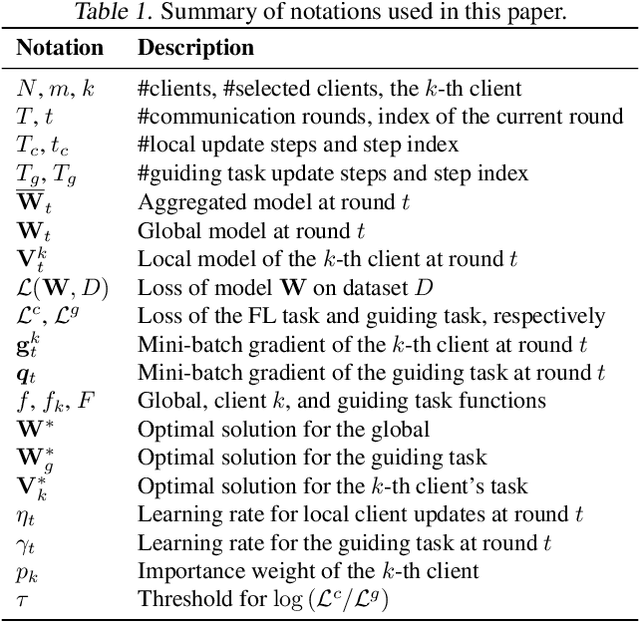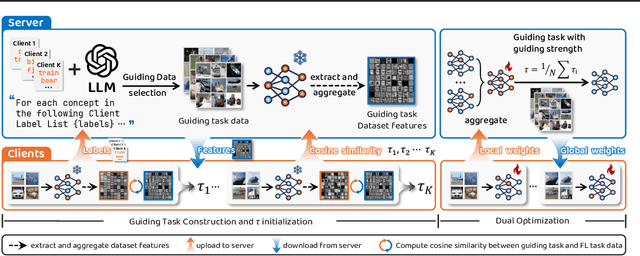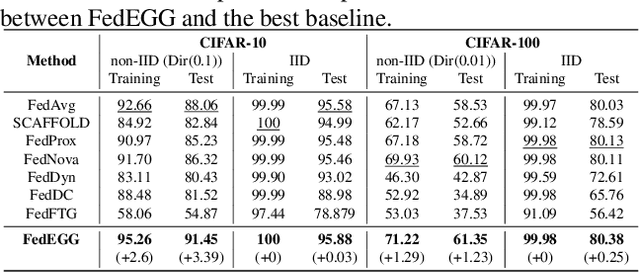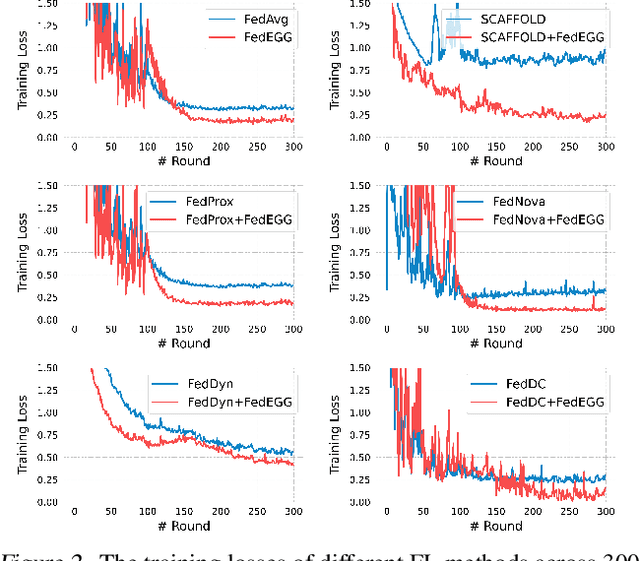Guangnan Ye
Teach2Eval: An Indirect Evaluation Method for LLM by Judging How It Teaches
May 18, 2025Abstract:Recent progress in large language models (LLMs) has outpaced the development of effective evaluation methods. Traditional benchmarks rely on task-specific metrics and static datasets, which often suffer from fairness issues, limited scalability, and contamination risks. In this paper, we introduce Teach2Eval, an indirect evaluation framework inspired by the Feynman Technique. Instead of directly testing LLMs on predefined tasks, our method evaluates a model's multiple abilities to teach weaker student models to perform tasks effectively. By converting open-ended tasks into standardized multiple-choice questions (MCQs) through teacher-generated feedback, Teach2Eval enables scalable, automated, and multi-dimensional assessment. Our approach not only avoids data leakage and memorization but also captures a broad range of cognitive abilities that are orthogonal to current benchmarks. Experimental results across 26 leading LLMs show strong alignment with existing human and model-based dynamic rankings, while offering additional interpretability for training guidance.
StageDesigner: Artistic Stage Generation for Scenography via Theater Scripts
Mar 04, 2025Abstract:In this work, we introduce StageDesigner, the first comprehensive framework for artistic stage generation using large language models combined with layout-controlled diffusion models. Given the professional requirements of stage scenography, StageDesigner simulates the workflows of seasoned artists to generate immersive 3D stage scenes. Specifically, our approach is divided into three primary modules: Script Analysis, which extracts thematic and spatial cues from input scripts; Foreground Generation, which constructs and arranges essential 3D objects; and Background Generation, which produces a harmonious background aligned with the narrative atmosphere and maintains spatial coherence by managing occlusions between foreground and background elements. Furthermore, we introduce the StagePro-V1 dataset, a dedicated dataset with 276 unique stage scenes spanning different historical styles and annotated with scripts, images, and detailed 3D layouts, specifically tailored for this task. Finally, evaluations using both standard and newly proposed metrics, along with extensive user studies, demonstrate the effectiveness of StageDesigner. Project can be found at: https://deadsmither5.github.io/2025/01/03/StageDesigner/
ArtNVG: Content-Style Separated Artistic Neighboring-View Gaussian Stylization
Dec 25, 2024



Abstract:As demand from the film and gaming industries for 3D scenes with target styles grows, the importance of advanced 3D stylization techniques increases. However, recent methods often struggle to maintain local consistency in color and texture throughout stylized scenes, which is essential for maintaining aesthetic coherence. To solve this problem, this paper introduces ArtNVG, an innovative 3D stylization framework that efficiently generates stylized 3D scenes by leveraging reference style images. Built on 3D Gaussian Splatting (3DGS), ArtNVG achieves rapid optimization and rendering while upholding high reconstruction quality. Our framework realizes high-quality 3D stylization by incorporating two pivotal techniques: Content-Style Separated Control and Attention-based Neighboring-View Alignment. Content-Style Separated Control uses the CSGO model and the Tile ControlNet to decouple the content and style control, reducing risks of information leakage. Concurrently, Attention-based Neighboring-View Alignment ensures consistency of local colors and textures across neighboring views, significantly improving visual quality. Extensive experiments validate that ArtNVG surpasses existing methods, delivering superior results in content preservation, style alignment, and local consistency.
DiffPatch: Generating Customizable Adversarial Patches using Diffusion Model
Dec 02, 2024Abstract:Physical adversarial patches printed on clothing can easily allow individuals to evade person detectors. However, most existing adversarial patch generation methods prioritize attack effectiveness over stealthiness, resulting in patches that are aesthetically unpleasing. Although existing methods using generative adversarial networks or diffusion models can produce more natural-looking patches, they often struggle to balance stealthiness with attack effectiveness and lack flexibility for user customization. To address these challenges, we propose a novel diffusion-based customizable patch generation framework termed DiffPatch, specifically tailored for creating naturalistic and customizable adversarial patches. Our approach enables users to utilize a reference image as the source, rather than starting from random noise, and incorporates masks to craft naturalistic patches of various shapes, not limited to squares. To prevent the original semantics from being lost during the diffusion process, we employ Null-text inversion to map random noise samples to a single input image and generate patches through Incomplete Diffusion Optimization (IDO). Notably, while maintaining a natural appearance, our method achieves a comparable attack performance to state-of-the-art non-naturalistic patches when using similarly sized attacks. Using DiffPatch, we have created a physical adversarial T-shirt dataset, AdvPatch-1K, specifically targeting YOLOv5s. This dataset includes over a thousand images across diverse scenarios, validating the effectiveness of our attack in real-world environments. Moreover, it provides a valuable resource for future research.
DogLayout: Denoising Diffusion GAN for Discrete and Continuous Layout Generation
Nov 30, 2024



Abstract:Layout Generation aims to synthesize plausible arrangements from given elements. Currently, the predominant methods in layout generation are Generative Adversarial Networks (GANs) and diffusion models, each presenting its own set of challenges. GANs typically struggle with handling discrete data due to their requirement for differentiable generated samples and have historically circumvented the direct generation of discrete labels by treating them as fixed conditions. Conversely, diffusion-based models, despite achieving state-of-the-art performance across several metrics, require extensive sampling steps which lead to significant time costs. To address these limitations, we propose \textbf{DogLayout} (\textbf{D}en\textbf{o}ising Diffusion \textbf{G}AN \textbf{Layout} model), which integrates a diffusion process into GANs to enable the generation of discrete label data and significantly reduce diffusion's sampling time. Experiments demonstrate that DogLayout considerably reduces sampling costs by up to 175 times and cuts overlap from 16.43 to 9.59 compared to existing diffusion models, while also surpassing GAN based and other layout methods. Code is available at https://github.com/deadsmither5/DogLayout.
Towards Million-Scale Adversarial Robustness Evaluation With Stronger Individual Attacks
Nov 20, 2024



Abstract:As deep learning models are increasingly deployed in safety-critical applications, evaluating their vulnerabilities to adversarial perturbations is essential for ensuring their reliability and trustworthiness. Over the past decade, a large number of white-box adversarial robustness evaluation methods (i.e., attacks) have been proposed, ranging from single-step to multi-step methods and from individual to ensemble methods. Despite these advances, challenges remain in conducting meaningful and comprehensive robustness evaluations, particularly when it comes to large-scale testing and ensuring evaluations reflect real-world adversarial risks. In this work, we focus on image classification models and propose a novel individual attack method, Probability Margin Attack (PMA), which defines the adversarial margin in the probability space rather than the logits space. We analyze the relationship between PMA and existing cross-entropy or logits-margin-based attacks, and show that PMA can outperform the current state-of-the-art individual methods. Building on PMA, we propose two types of ensemble attacks that balance effectiveness and efficiency. Furthermore, we create a million-scale dataset, CC1M, derived from the existing CC3M dataset, and use it to conduct the first million-scale white-box adversarial robustness evaluation of adversarially-trained ImageNet models. Our findings provide valuable insights into the robustness gaps between individual versus ensemble attacks and small-scale versus million-scale evaluations.
White-box Multimodal Jailbreaks Against Large Vision-Language Models
May 28, 2024



Abstract:Recent advancements in Large Vision-Language Models (VLMs) have underscored their superiority in various multimodal tasks. However, the adversarial robustness of VLMs has not been fully explored. Existing methods mainly assess robustness through unimodal adversarial attacks that perturb images, while assuming inherent resilience against text-based attacks. Different from existing attacks, in this work we propose a more comprehensive strategy that jointly attacks both text and image modalities to exploit a broader spectrum of vulnerability within VLMs. Specifically, we propose a dual optimization objective aimed at guiding the model to generate affirmative responses with high toxicity. Our attack method begins by optimizing an adversarial image prefix from random noise to generate diverse harmful responses in the absence of text input, thus imbuing the image with toxic semantics. Subsequently, an adversarial text suffix is integrated and co-optimized with the adversarial image prefix to maximize the probability of eliciting affirmative responses to various harmful instructions. The discovered adversarial image prefix and text suffix are collectively denoted as a Universal Master Key (UMK). When integrated into various malicious queries, UMK can circumvent the alignment defenses of VLMs and lead to the generation of objectionable content, known as jailbreaks. The experimental results demonstrate that our universal attack strategy can effectively jailbreak MiniGPT-4 with a 96% success rate, highlighting the vulnerability of VLMs and the urgent need for new alignment strategies.
FedCAda: Adaptive Client-Side Optimization for Accelerated and Stable Federated Learning
May 20, 2024Abstract:Federated learning (FL) has emerged as a prominent approach for collaborative training of machine learning models across distributed clients while preserving data privacy. However, the quest to balance acceleration and stability becomes a significant challenge in FL, especially on the client-side. In this paper, we introduce FedCAda, an innovative federated client adaptive algorithm designed to tackle this challenge. FedCAda leverages the Adam algorithm to adjust the correction process of the first moment estimate $m$ and the second moment estimate $v$ on the client-side and aggregate adaptive algorithm parameters on the server-side, aiming to accelerate convergence speed and communication efficiency while ensuring stability and performance. Additionally, we investigate several algorithms incorporating different adjustment functions. This comparative analysis revealed that due to the limited information contained within client models from other clients during the initial stages of federated learning, more substantial constraints need to be imposed on the parameters of the adaptive algorithm. As federated learning progresses and clients gather more global information, FedCAda gradually diminishes the impact on adaptive parameters. These findings provide insights for enhancing the robustness and efficiency of algorithmic improvements. Through extensive experiments on computer vision (CV) and natural language processing (NLP) datasets, we demonstrate that FedCAda outperforms the state-of-the-art methods in terms of adaptability, convergence, stability, and overall performance. This work contributes to adaptive algorithms for federated learning, encouraging further exploration.
The Dog Walking Theory: Rethinking Convergence in Federated Learning
Apr 18, 2024



Abstract:Federated learning (FL) is a collaborative learning paradigm that allows different clients to train one powerful global model without sharing their private data. Although FL has demonstrated promising results in various applications, it is known to suffer from convergence issues caused by the data distribution shift across different clients, especially on non-independent and identically distributed (non-IID) data. In this paper, we study the convergence of FL on non-IID data and propose a novel \emph{Dog Walking Theory} to formulate and identify the missing element in existing research. The Dog Walking Theory describes the process of a dog walker leash walking multiple dogs from one side of the park to the other. The goal of the dog walker is to arrive at the right destination while giving the dogs enough exercise (i.e., space exploration). In FL, the server is analogous to the dog walker while the clients are analogous to the dogs. This analogy allows us to identify one crucial yet missing element in existing FL algorithms: the leash that guides the exploration of the clients. To address this gap, we propose a novel FL algorithm \emph{FedWalk} that leverages an external easy-to-converge task at the server side as a \emph{leash task} to guide the local training of the clients. We theoretically analyze the convergence of FedWalk with respect to data heterogeneity (between server and clients) and task discrepancy (between the leash and the original tasks). Experiments on multiple benchmark datasets demonstrate the superiority of FedWalk over state-of-the-art FL methods under both IID and non-IID settings.
SilverSight: A Multi-Task Chinese Financial Large Language Model Based on Adaptive Semantic Space Learning
Apr 07, 2024



Abstract:Large language models (LLMs) are increasingly being applied across various specialized fields, leveraging their extensive knowledge to empower a multitude of scenarios within these domains. However, each field encompasses a variety of specific tasks that require learning, and the diverse, heterogeneous data across these domains can lead to conflicts during model task transfer. In response to this challenge, our study introduces an Adaptive Semantic Space Learning (ASSL) framework, which utilizes the adaptive reorganization of data distributions within the semantic space to enhance the performance and selection efficacy of multi-expert models. Utilizing this framework, we trained a financial multi-task LLM named "SilverSight". Our research findings demonstrate that our framework can achieve results close to those obtained with full data training using only 10% of the data, while also exhibiting strong generalization capabilities.
 Add to Chrome
Add to Chrome Add to Firefox
Add to Firefox Add to Edge
Add to Edge